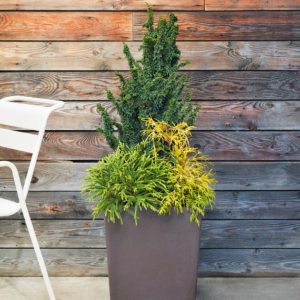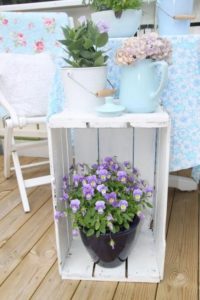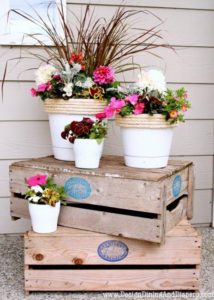Planting a tree is a long-term investment. Besides adding beauty to your landscape, a tree helps the environment by taking up carbon dioxide, the greenhouse gas that is such a big driver in climate change. It can provide shade to relax in on a hot summer day, as well as reduce the energy costs of cooling your home, or act as a windbreak to help cut winter fuel bills. And it can provide food and habitat for the creatures big and small that share your landscape. You’ll reap the biggest dividends if you take the time to get your young tree off to the best start by planting and caring for it correctly. Consider a well-grown tree a gift not only to yourself but to the generations to come who will enjoy it spreading branches.
Start by Finding the Trunk Flare
Tree roots need water, but they also need oxygen. The root system of a tree that is planted too deep will slowly suffocate. Too deep planting can also encourage the formation of circling roots will girdle or choke and kill the tree as it grows. So it’s very important to plant your new tree at the correct depth. The best way to do this is to make sure you find the trunk flare on your tree before you put it in the ground.
What do we mean by trunk flare? Start by looking at a tree that has grown naturally in the landscape. You’ll see that the base of the trunk gradually widens or flares out as it enters the ground. If you pull back some of the soil at the base of the tree, you’ll see the tops of the main order roots spreading out at this point. You want to plant your own tree so that the base of the trunk flare (also known as the root collar) is right at the surface of the soil (or slightly above in heavy soil). The flare of the trunk on a sapling is not as noticeable as it is on a mature tree, but if you look closely, you’ll see it — that is, if it’s not buried.
And there’s the problem. With both trees grown in containers and those sold with balled and burlapped (B & B) root balls, the trunk flare frequently gets buried in the course of digging or repotting. When the root balls of B & B trees are dug up, quite a bit of soil often gets thrown up around the base of the trunk before the ball gets wrapped in burlap. And when container-grown trees are repotted, they may end up with their trunk flares below soil level.
So forget the old advice to simply measure the height of the root ball to figure out how deep to dig the planting hole. If the trunk flare isn’t visible, find it by carefully pulling away the soil around the base of the trunk until you see the trunk flare.
Then dig the planting hole only as deep as the distance from the trunk flare to the bottom of the root ball. Why only this deep? Why not loosen the soil at the bottom of the hole before you set the tree in? Because you want to be sure the tree doesn’t sink down after planting. You need to set the root ball on undisturbed soil so that the ground below the ball won’t settle after you set it in the ground, causing the tree to end up planted too deep.
But first, before you begin digging your planting hole, check for underground utilities by calling. Also check for overhead obstacles such as electrical and phone lines. Remember – your tree will grow!
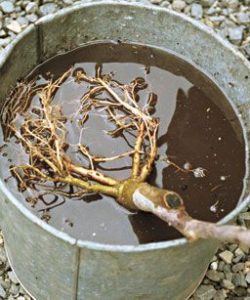
If it is bare root, soak overnight.
Make a Broad Planting Hole
As for the width of the hole, make it broad, at least two to three times the width of the root ball; as much as five times the width in compacted soil. Slope the sides of the planting hole outwards at a shallow angle (think of making a saucer, not a pit) and rough them up with the edge of your spade. This is especially important in clay soils where digging can leave the sides of the hole slicked over and hard for plant roots to penetrate.
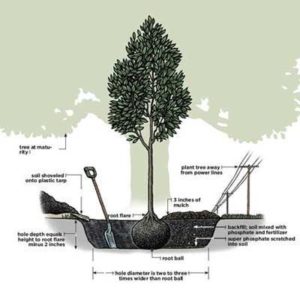
Set the Tree in the Hole
With container-grown trees, slide the root ball out of its pot or cut it away if necessary. Loosen and spread out the roots on the outside of the rootball before setting it in the planting hole. With a B & B root ball, trim away the burlap and remove any twine. If the ball is in a wire basket, cut and fold back the wire from at least the top half of the ball; ideally you’d like to remove all the wire. This may be easier to do once the ball is in the hole. Basically, you’re trying to remove as much non-plant material as possible without causing the root ball to fall apart. If you notice any roots that are kinked or encircling the root ball, trim these away.
Check that the trunk flare is positioned so that it will emerge even with or slightly above the soil level when the planting hole is filled. Laying a long-handled tool like a garden rake across the span of the hole will help you figure where the soil level will be when the hole is filled in.
Be sure not to hold the tree by its trunk as you move it into the planting hole. And be careful not to drop the ball into the hole, as this can break off roots within the ball. If the root ball is heavy (and soil does weigh a lot!), try using a tarp under the ball to drag it carefully into the hole, using a plank of wood as a slide if needed.
Once the tree is in the hole, walk around and look at it from all directions and adjust it so that the trunk is straight, if necessary. It’s almost impossible to reposition a tree after you’ve filled the hole with soil!
Backfill with Native Soil
Now it’s time to backfill the planting hole with soil. Your first impulse may be to add lots of fertilizer and organic matter to the soil you put back in the hole. But stop! Your tree will do best if you use only the native soil to refill the hole. Why not improve this backfill soil? Because doing so will encourage roots to stay within the pocket of hospitable improved soil rather than crossing the boundary into the native soil to become established, which will ultimately interfere with the long-term health of the tree. And if you are planting in heavy soil and you fill the planting hole with lighter, more porous amended soil, the roots can drown as the hole fills up with water during rainy weather, just like a bathtub, with the water held in by the heavier soil outside the hole. So stick with the policy of what came out of the planting hole is all that goes back in.
Start by filling the hole about halfway with native soil, breaking up any large clumps with your shovel while taking care not to damage any tree roots. Then add 5-10 gallons of water to the hole and let it drain through, settling the soil to remove any air pockets. Add the remaining backfill, using the leftover soil to create a low berm around the edge of the planting hole to contain water. Firm the soil in the hole with your hands, not your feet, or you can compact the soil and restrict the growth of the roots. Then add another 5-10 gallons of water.
Stake only if Necessary
Staking is something else that most gardeners think is a must. But in many cases this is a task you can skip. Only stake your newly planted tree if necessary. Most trees with trunks smaller than two inches in diameter don’t need staking unless their root ball is crumbling; they are planted on a slope, are sited in a very windy location, or have a badly bowed trunk. The natural movement of an unstaked tree helps it to develop a sturdier trunk and a more robust root system.
If you do stake your tree, erect two stakes on opposite sides of the trunk. Attach flexible ties such as 3-inch wide nylon webbing straps on the lower half of the trunk and secure the ties to the stakes with heavy gauge wire. Stake loosely enough to allow some trunk movement; this is important for normal root and trunk development. Be sure to remove the stakes and ties as soon as the tree is established, usually after the first season of growth. Also remove any tags or trunk guards on the top of the tree at planting time. If you leave these on long-term, they may eventually girdle the tree as it grows, harming or even killing the tree.
Mulch Mindfully
Finally, spread mulch such as wood chips or shredded bark 2-4 inches deep over the root zone of the newly planted tree to help conserve soil moisture and keep weeds down. But don’t make a mulch ″volcano.″ Piling mulch up against the trunk can lead to rot and disease. Instead, leave about 6 inches of bare soil between the trunk and the mulch.
Give Follow-Up Care
Keep your young tree well-watered during its first season in the ground, but don’t overwater. The frequency of watering needed will depend on soil type, temperature, and rainfall, so check the soil moisture in both the rootball and the backfill a couple times a week. A houseplant moisture meter is a handy tool for this task. When you do water, add enough water to soak the entire depth of the rootball; don’t just wet the top few inches of soil with a light sprinkling. Then let the top 3 inches of soil dry out before re-watering.
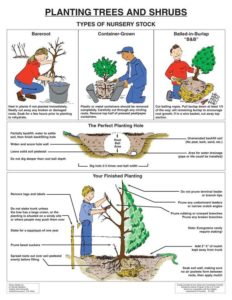
Plant Shrubs Properly Too!
These same basic techniques apply when you are planting shrubs as well. Multi-stemmed shrubs won’t have a distinct trunk flare like a tree trunk does. But you’ll want to place a shrub so that its crown (where the stems and roots come together) is right at the soil surface or slightly above it, with the rootball resting on undisturbed soil, and follow the same guidelines for width of the planting hole, backfilling, and mulching.







